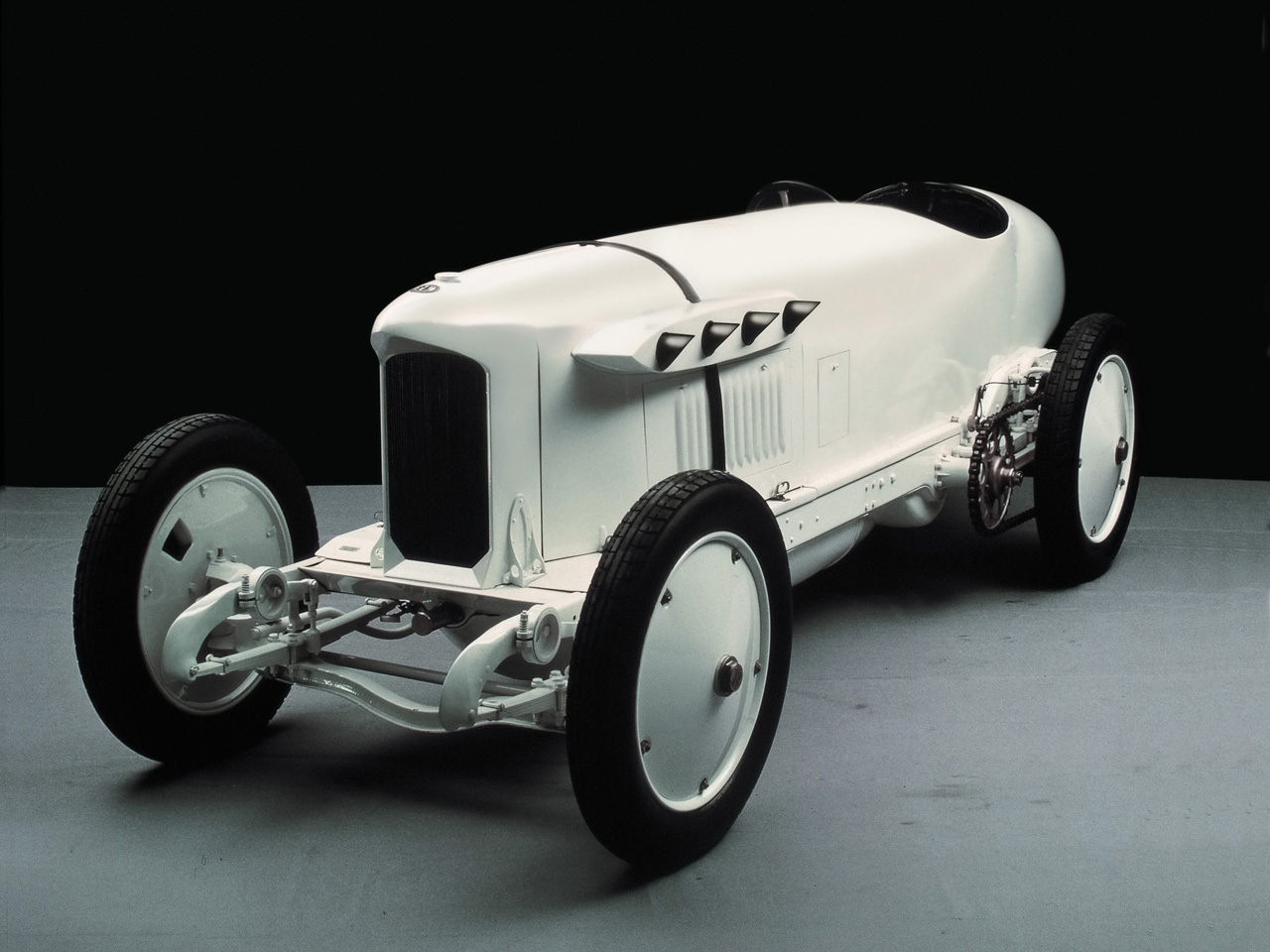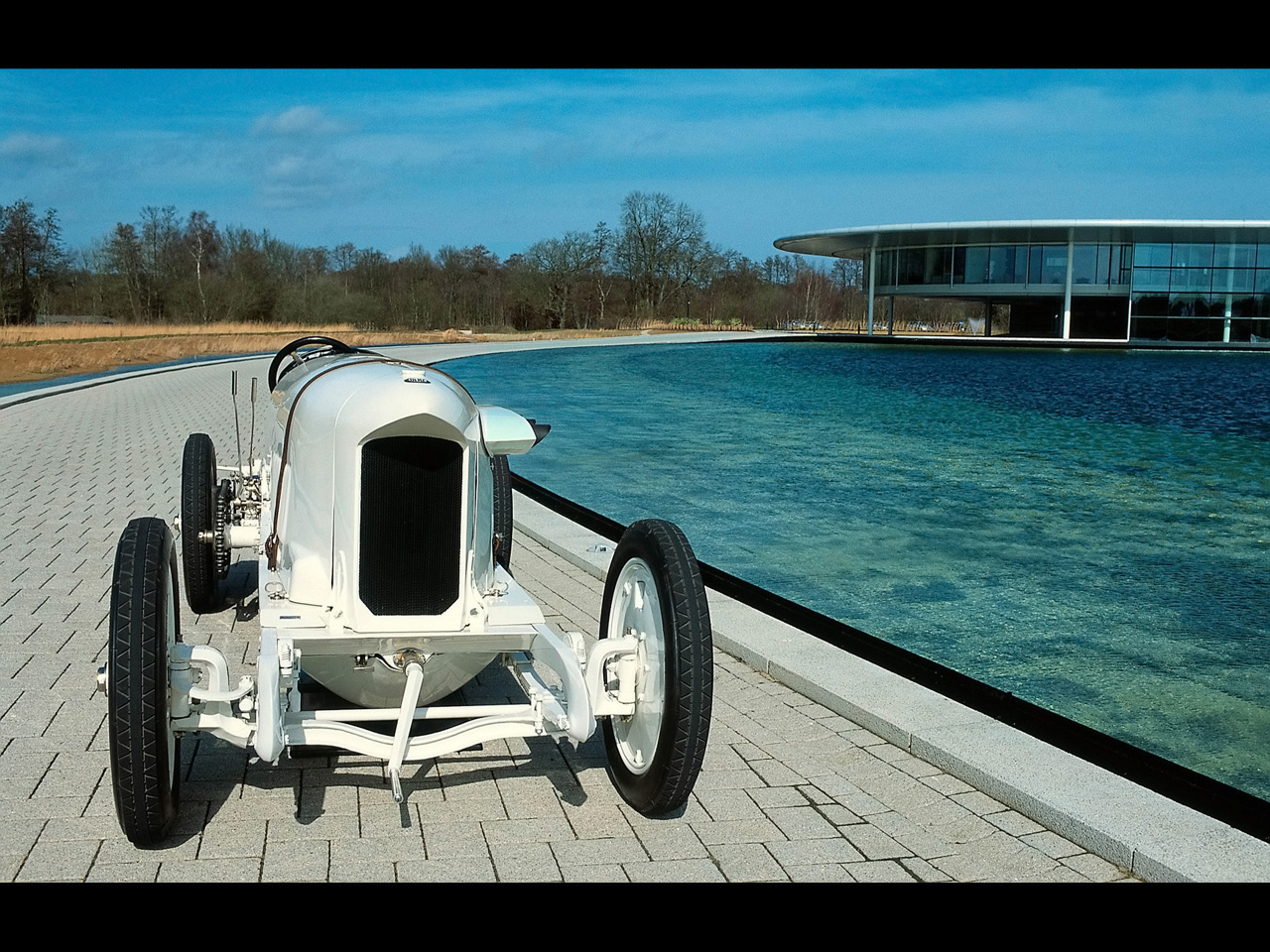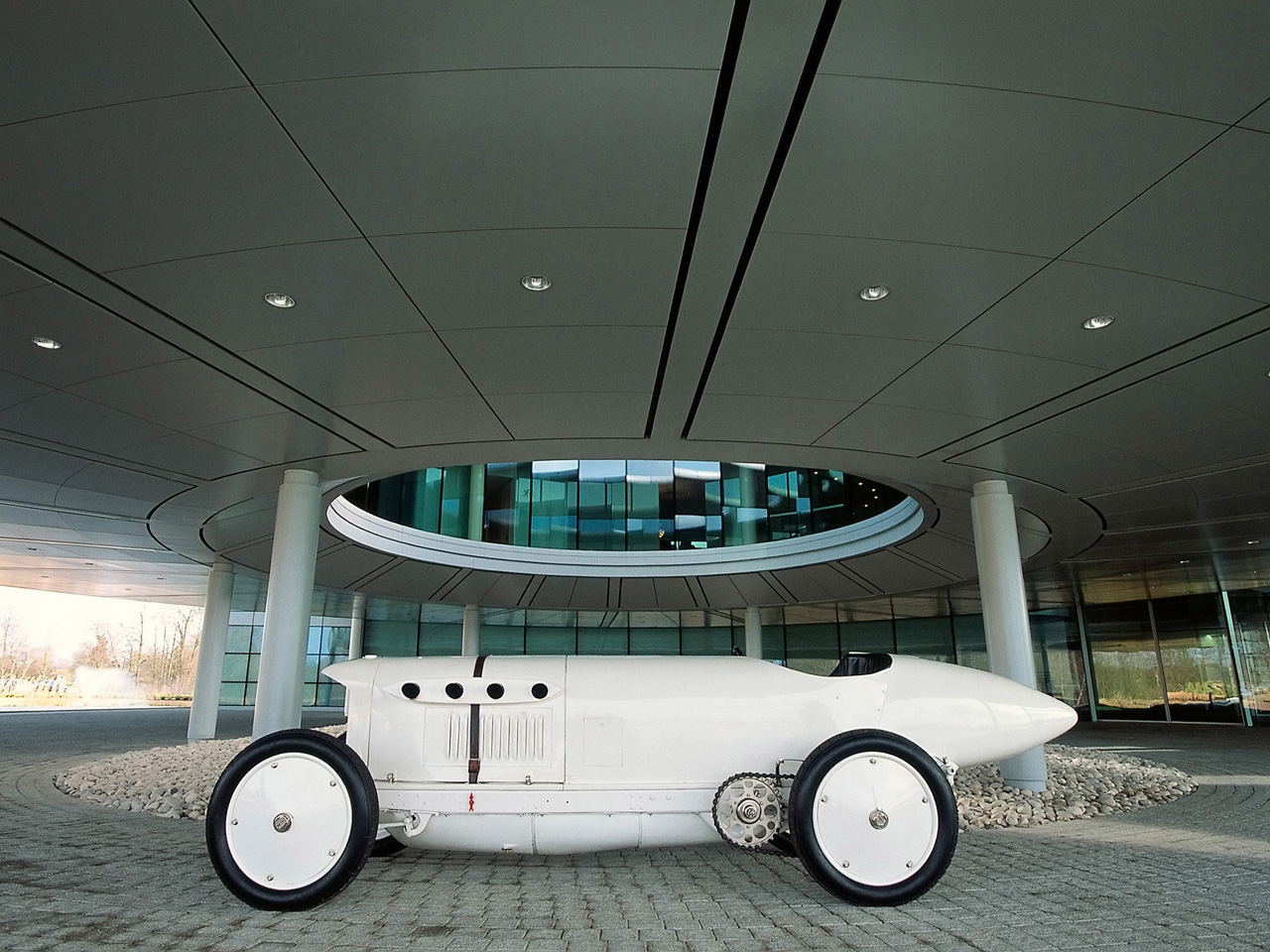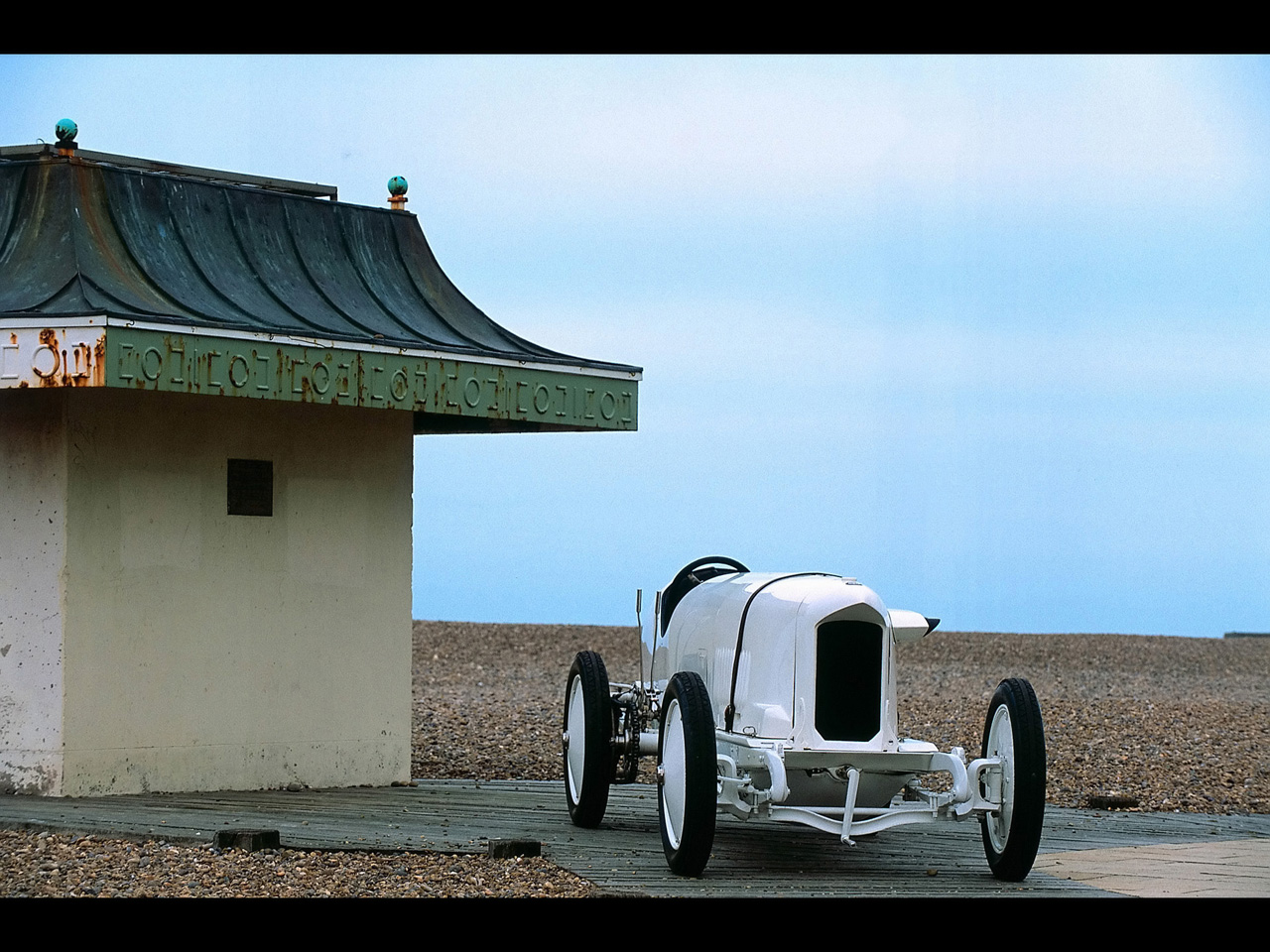1909 Blitzen-Benz
|
Price |
-- |
Production |
6 | ||
|
Engine |
21.5 Liter 4-cylinder |
Weight |
-- | ||
|
Aspiration |
-- |
Torque |
-- | ||
|
HP |
200 hp @ 1600 rpm |
HP/Weight |
-- | ||
|
HP/Liter |
9.3 hp per liter |
1/4 mile |
-- | ||
|
0-62 mph |
-- |
Top Speed |
140.21 mph |
(Daimler-Chrysler Press Release) Stuttgart, Mar 24, 2006 228.1
km/h - faster than any other vehicle on land had ever been. The
world record car was a 200 hp Lightning Benz piloted by Bob Burman
on April 23, 1911 at Daytona Beach, Florida/USA, over one kilometer
from a flying start. Over one mile from a flying start, he recorded
an average speed of 225.65 km/h. These records remained unbroken
until 1919. The Benz had been twice as fast as contemporary
aircraft, and also surpassed the record for rail-bound means of
transport (1903: 210 km/h).
The Lightning Benz had quite intentionally been built as a sports
car by Benz & Cie. in 1909 - with the aim of breaking through what
was a magical barrier - 200 km/h (124.26 mph) - at the time. The
basis was the 150 hp engine from the Grand Prix car, but this output
was not sufficient for the ambitious project. Displacement was
enlarged to 21.5 liters - no other racing or record car engine from
Benz & Cie., Daimler-Motoren-Gesellschaft or Daimler-Benz AG would
ever be larger. The first version of this engine developed 184 hp at
1500/min, and in meticulous fine-tuning work, this output was
eventually boosted to 200 hp at 1600/min. The car was then built
around this engine, using the chassis of the Grand Prix car. In
accordance with the model designation logic customary at Benz, the
car was named 200 hp Benz.
The car proved its mettle in its very first race: in the one-kilometer
race in Frankfurt/Main, Fritz Erle won at an average speed of 159.3
km/h from a flying start. The 200 hp Benz went on to tour the record
tracks in good old Europe, among them the concrete oval at
Brooklands/England. In the process, it pushed all the hitherto
existing limits a little further, and soon proved that the race
tracks in Europe were too short and too narrow for the speeds
aspired to.
In 1910, the car was fitted with new bodywork and shipped to
America. It was bought by event manager Ernie Moross and given the
punchy name Lightning Benz because the car was as quick as
lightning. And before very long, Barney Oldfield broke the existing
world record by reaching a speed of 211.97 km/h in Daytona Beach.
With a new name - “Blitzen-Benz” - the car became an attraction
which toured the USA much like a traveling circus. It was at the
wheel of this car that Bob Burman established the new world speed
record in April 1911.
There were six Lightning Benz units altogether. Two of these still
exist today - one is owned by Mercedes-Benz, the other one by a
collector in the USA. In 2004, another brand enthusiast in the USA
privately built a replica of this car, using several original parts
and cooperating closely with Mercedes-Benz Classic. In this project,
the Lightning Benz in the museum served to provide authentic
orientation while being expertly restored and made operational again
at the same time. The authentic Lightning Benz is a very special
exhibit in the “Silver Arrows - Races & Records” section of the new
Mercedes-Benz Museum.
Origins
The late nineteenth century was a unique era for technological
pioneers like Karl Benz and Gottlieb Daimler. For many years the two
engineers had been working independently on the realization of a
human dream - individual mobility. Both men recognized the key to
this was a compact combustion engine capable of powering a vehicle,
and eventually both came up with a design for a car. Karl Benz
registered his Motor Car for a patent in January 1886, and Gottlieb
Daimler came along just a few weeks later with his horseless
carriage. The Blitzen-Benz held by the Mercedes-Benz
Museum
1935 was dominated by a major anniversary at Daimler-Benz. It had
been 50 years since the company started to make automobiles and
another 200-hp Benz - the car which can currently be found at the
Mercedes-Benz Museum - was built from the parts still at hand as an
exhibition piece for the celebrations. Some of the components were
taken from the “grandmother”, others - the hub locks, for example,
and probably the radiator and the central section of the body - from
the wreckage of Hornsted’s Blitzen. In order to make the car look
slightly more aerodynamic, the wood-spoke wheels were fitted with
aluminum covers. Plus, the engine cover, rear section and the cover
of the truncated exhaust were all newly manufactured. Lightning strikes twice There were still two other 200-hp Benz cars in circulation.
Madrid-based Benz dealer Treumann sold car no. 5 (engine number
9145) to Mr. J. Ratis in Barcelona and the customer received his
Benz on February 20, 1913. What happened to it next is unknown. Meanwhile, the Benz dealership in Antwerp, Belgium, sold Blitzen-Benz
no. 6 to a Mr. M. Heje from Gent, who took delivery of the car on
December 24, 1913, thereby setting himself a very special Christmas
present. This was the only Blitzen (engine number 13280) with an
extended chassis (3200 mm instead of 2800 mm) and a four-seat
touring body. The latest model was also a frequent entrant in record
attempts at Brooklands. The car remained in England for a long time,
before being acquired by an American collector in 2002. A new chapter in the history of the Blitzen-Benz
Indeed, 2004 has seen the latest Blitzen-Benz taking shape, an
American collector refusing to be intimidated by the costs involved
and commissioning the construction of what is in effect the seventh
200-hp Benz. In a remarkable show of trust, the Mercedes-Benz Museum
loaned him its own Blitzen-Benz for a period of a year to serve as a
template for this most extraordinary of projects. Mercedes also
supplied the parts from the Hornsted car still held in its stocks-
including engine no. 9141 and several other essential components -
in order to add as much authenticity as possible to the
reproduction. Sections of an original body, meanwhile, were still
available in the USA.
It was an historic event not lost on Gottlieb Daimler. As a man of
vision Gottlieb Daimler looked well beyond the latest technological
developments, and predicted that the internal combustion engine
would mobilize people “on land, on water and in the air”.
A few years earlier, in 1876, the gifted designer and close friend
of Daimler, Wilhelm Maybach, had become acquainted with the
businessman William Steinway, whose New York company manufactured
pianos in the tradition of his German forefathers. During one of his
visits to Germany in 1888, Steinway also got to know Gottlieb
Daimler. Their conversations returned repeatedly to the same
subject: the manufacture of Daimler products under license in
America. Shortly after Steinway’s return to America the matter was
settled. On September 29, 1888, Daimler Motor Co. was established
with headquarters on Long Island, New York. Thus, Daimler-Motoren-Gesellschaft
(DMG) became the first European car producer to have a presence in
the United States and the agreement additionally covered use of the
Daimler licenses for the manufacture of stationary and marine
engines.
In August 1890 the first four-cylinder Mercedes engine designed by
Wilhelm Maybach was shipped to New York. The unit weighed 451
kilograms, and with a six-liter displacement delivered 12.3 hp at
390/min. Ten days later a second engine arrived, a variant developed
in parallel, with a 2.4-liter displacement, weighing 153 kilograms
and producing 5.9 hp at 620/min. Both versions were designed for use
as marine engines.
In 1891, William Steinway’s Daimler Motor Co. manufactured under
license America’s first fully operational vehicle engine in
Hartford/Connecticut using the original plans drawn up by Gottlieb
Daimler.
The early years were not without challenges, but in 1893 at the
World Exhibition in Chicago, DMG presented the USA with its first
fully operational automobile, and sales figures for the engines
began to take off. A modified version of the “wire-wheeled car” was
put on show. Gottlieb Daimler visited the exhibition himself during
his honeymoon with his second wife Lina - the question of car
production in the United States still very much in his thoughts.
In a newspaper interview given in 1895, William Steinway described
his vision of the motorization of America: “The cars we intend to
produce for the American market will carry two to four persons and
will be powered by an engine of 2 ½ - 3 ½ hp. Each car will have
four gears of varying speeds: 3 ½, 6, 9 and 14 miles per hour. The
fuel, namely petroleum, costs approximately one cent per hp and per
hour, which is considerably cheaper than horse power. … We had a
horseless car here in 1893, although it was too lightly built for
our cobbles and uneven streets. We shall therefore bring out a model
adapted to American circumstances.” Steinway’s plans all sounded
very concrete. But he was to die in November 1896, and his heirs,
unconvinced that the car would be a money-maker, sold their share in
Daimler Motor Co. to General Electric Company. After restructuring,
the American production facility changed its name in 1898 to Daimler
Manufacturing Company.
When Gottlieb Daimler died on March 6, 1900, DMG continued in its
founder’s internationalist tradition, and the idea of production in
America was never far from mind. The first “American Mercedes” was
finally built in 1905, an exact replica of the 45 hp Mercedes as
being manufactured in Cannstatt.
As for Karl Benz, sought out the American market at an early stage.
His first vehicles were sold in the 1890s under the names “Eclair”
and “Roger”. More than anything, however, the name Benz became
associated with the first car race to be held on American soil on
November 2, 1895. The course covered a distance of 92 miles from
Chicago to Waukegan and back, but a terrible storm on race day meant
that only two of the more than 80 cars registered turned up for the
start, and the race was postponed.
Nevertheless, the two vehicles set off on the course, and one -
Oscar Mueller driving a Benz - reached the finish. It was several
years before Benz’s next major automotive triumph, but when it came,
it was with a great roll of drums. With almost no preparation,
Barney Oldfield took to the wheel of the “Lightning Benz” on March
17, 1910, in search of speed records on the beach at
Daytona/Florida. He set a new best mark of 211.97 km/h.
On April 23, 1911, it was Bob Burman’s turn to exploit the full
potential of the “Blitzen-Benz” at Daytona Beach, setting an average
speed for the flying mile of 225.65 km/h and a new land speed record
of 228.1 km/h over the flying kilometer - a mark that would stand
until 1919. The “Blitzen-Benz” became a celebrated attraction as it
traveled across the country and during this era laid the foundations
for the excellent reputation of the Benz brand in the United States.
In 1926 the two companies merged to become Daimler-Benz AG and from
then on conducted their US business jointly as Mercedes-Benz
Company. The records of sales figures prior to the Second World War
are rather sketchy, but it is thought that in total about 200
vehicles were imported. The Second World War brought commercial
activities in the USA temporarily to a halt, but the brand name
Mercedes-Benz was never forgotten.



